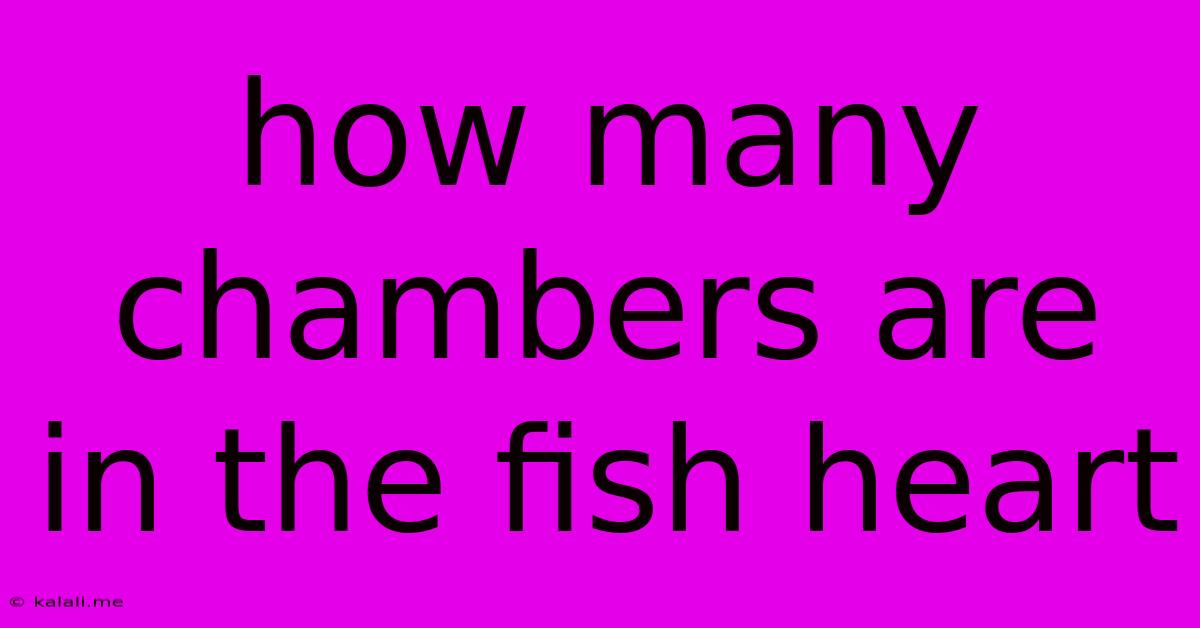How Many Chambers Are In The Fish Heart
Kalali
Jun 14, 2025 · 3 min read

Table of Contents
How Many Chambers Does a Fish Heart Have? A Deep Dive into Fish Cardiovascular Systems
Fish, those fascinating creatures inhabiting the world's aquatic environments, possess a surprisingly simple yet efficient circulatory system. Understanding their cardiovascular anatomy, particularly the number of chambers in their heart, is key to appreciating their unique adaptations to aquatic life. This article will explore the structure of a fish heart, explaining why it only has two chambers and how this differs from the hearts of other vertebrates.
A fish heart only has two chambers: one atrium and one ventricle. This is significantly different from the four-chambered hearts found in mammals and birds, or the three-chambered hearts of amphibians and reptiles (excluding crocodiles). This simple structure is perfectly suited to their lifestyle and metabolic needs.
The Two-Chambered Heart: A Closer Look
-
The Atrium: This thin-walled chamber receives deoxygenated blood from the body via the sinus venosus. The sinus venosus is a thin-walled sac that acts as a collecting chamber for blood returning to the heart. Think of it as a preliminary holding area before the blood moves into the atrium.
-
The Ventricle: This thicker-walled chamber is responsible for pumping the deoxygenated blood to the gills. The ventricle's muscular walls are strong enough to generate the pressure needed to push blood through the gill capillaries, where gas exchange takes place. From the gills, oxygenated blood is then circulated throughout the body.
Why Only Two Chambers?
The two-chambered heart in fish is a highly effective system for their single circulatory pathway. Unlike mammals and birds with their double circulatory systems (pulmonary and systemic), fish have a single circulatory system. Blood passes through the heart only once during each complete circuit of the body. A two-chambered heart is perfectly sufficient for this single circuit. Adding more chambers wouldn't offer significant advantages and would likely increase the complexity of the system unnecessarily. The simplicity of the two-chambered heart contributes to its efficiency in a low-pressure system.
Comparing Fish Hearts to Other Vertebrates
The evolution of the vertebrate heart showcases a fascinating progression in complexity. The move from a two-chambered heart in fish to more complex structures in other vertebrates reflects adaptations to different metabolic needs and environmental pressures. The development of a double circulatory system, with separate pulmonary and systemic circuits, allowed for much more efficient oxygen delivery to the body, particularly in air-breathing animals with higher metabolic rates.
Key Differences and Adaptations
Here's a table summarizing the key differences in heart structure across different vertebrate groups:
| Vertebrate Group | Number of Chambers | Circulatory System |
|---|---|---|
| Fish | Two (atrium and ventricle) | Single |
| Amphibians | Three (two atria and one ventricle) | Double, incomplete |
| Reptiles (except crocodiles) | Three (two atria and one ventricle) | Double, incomplete |
| Crocodiles, Birds, Mammals | Four (two atria and two ventricles) | Double, complete |
This shows the evolutionary pathway towards increasingly efficient oxygen delivery systems, culminating in the highly efficient four-chambered hearts found in birds and mammals.
In conclusion, the fish heart's two chambers—the atrium and the ventricle—are perfectly adapted to its single circulatory system and the demands of its aquatic lifestyle. Understanding this simple yet efficient structure provides valuable insight into the remarkable diversity and evolutionary adaptations within the vertebrate world.
Latest Posts
Latest Posts
-
What Is The Difference Between Observations And Inferences
Jun 15, 2025
-
Which Digestive Enzyme Hydrolyzes Protein In The Stomach
Jun 15, 2025
-
Which Of The Following Statements Best Describes Scientific Research
Jun 15, 2025
-
Applications Of Series And Parallel Circuits
Jun 15, 2025
-
35 Is What Percent Of 105
Jun 15, 2025
Related Post
Thank you for visiting our website which covers about How Many Chambers Are In The Fish Heart . We hope the information provided has been useful to you. Feel free to contact us if you have any questions or need further assistance. See you next time and don't miss to bookmark.